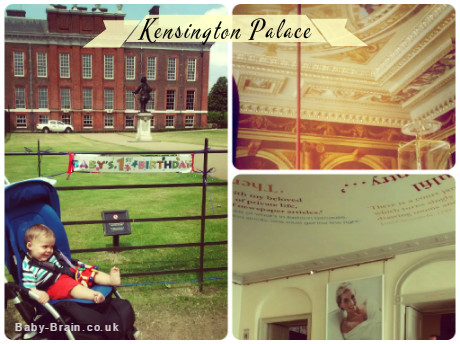Archives
How to play with a newborn baby (0-3 months) – what and why – psychology and research
…
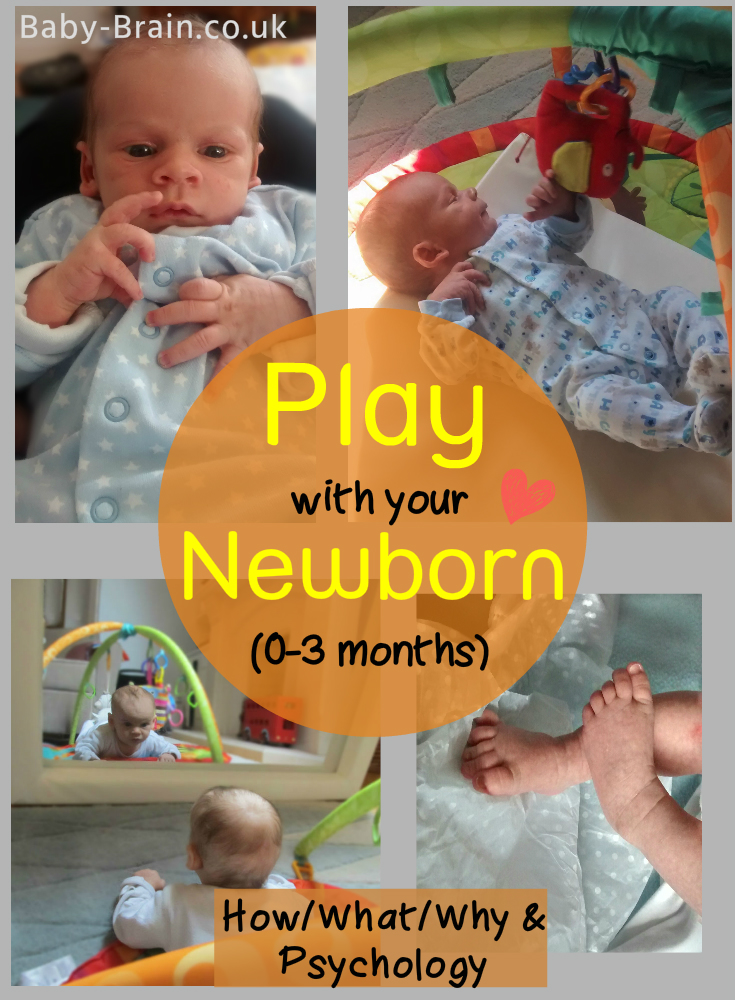
As I approach the 5th month with the new baby (already!) I was looking back and thinking of the ways that we “played”. There’s a lot of time in the day so how can you play with baby and what can you do all day long? Well, apart from nappy changes, sleeps, screams, baths and other practical “stuff”, here’s some ways we played together and some of the psychology/research behind activity ideas:
SOUND – COMMUNE
Talking:
Face to Face time is a GREAT way to play. This means simply being face to face with baby and having a chat. You can talk about anything; something that you did that day or just make certain sounds with some over the top mouth-moving to show how you’re making it, like B-B-B-B-B-B, OOoooo.
→ → → Talk in a funny voice!
Talking is important but it’s a case of Quality, not Quantity
Talking in “parentese” – that baby talk that we do, characterised by higher pitch, slowed down and exaggerated intonation (6) – might irritate some but apparently it has it’s benefits; slowing speech down and exaggerating sounds, also introducing that “sing song” element to the voice is something babies like. It works well with very young babies according to this article who report that prevalence of baby talk with children (in one to one conversations rather than in groups) was linked to better language development,
The more parents exaggerated vowels – for example “How are youuuuu?” – and raised the pitch of their voices, the more the 1-year olds babbled, which is a forerunner of word production.
When the babies were 2 years old, parents filled out a questionnaire measuring how many words their children knew. Infants who had heard more baby talk knew more words
Singing:
Again, communication is paramount so singing counts too. Apparently, from day one babies have an ability (innate) to discriminate rhythmic patterns. See this interesting article from Psychology Today for more but in sum, you can start in utero – around 25 weeks of pregnancy the baby starts to process auditory signals – which is why newborns may prefer their mother’s voice, because it is quite familiar to them!
Reading:
Reading from birth is a great thing to practice, and has benefits. See my reading page for more in-depth information on the psychology of reading with babies and small children. In brief, baby will recognise their mother’s voice from the womb (1) and hearing it from day one may be familiar and comforting to them, reassuring them of your presence (2).
When we read we usually read with different expression and voices than when we talk and books/reading materials contain different vocabularies, words, expressions than what we might use in every day talk around our children. This is useful because it exposes the child to more varied language and sounds.
Reading to babies from the early months has been found (3) to be related to increased reading with babies at 8 months old (creating a reading habit), which in turn, related to language abilities at 12 and 16 months, particularly with expressive language (being able to put thoughts into words and sentences).
Interaction when reading has also been highlighted as an important element in relation to language development (4) with older babies (12 months).
TOUCH
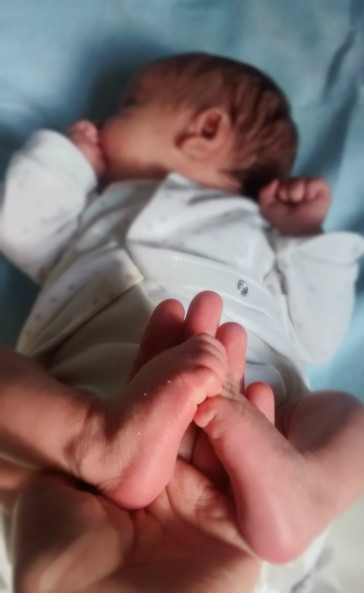
Touching feet
Touching hands, touching feet – we did a lot of this in month one, mainly because his little feet were so cute. The baby and I are due to take part in a research study soon at a Baby Lab about whether infants in the early months can distinguish between a social touch and other touch. This will involve monitoring activity and touching baby’s arm with a toothbrush and then touching by hand.
Skin to skin is recommended and touch is going to be important! Research has reported increased touch to facilitate growth and development (cited in 5). Research on benefits of touch with premature babies has also influenced procedures in some hospitals such as use of “kangaroo care” where the baby receives skin to skin contact being held upright against the bare chest of the carrier (5). There is a huge wealth of literature out there about importance of touch and skin to skin with babies and infants which I encourage you to read further if this is an area of interest to you.
Sensory play
We also did lots of sensory play such as touching soft toys, a range of textured material and letting him touch/kick his little feet on some crunchy sounding tissue paper.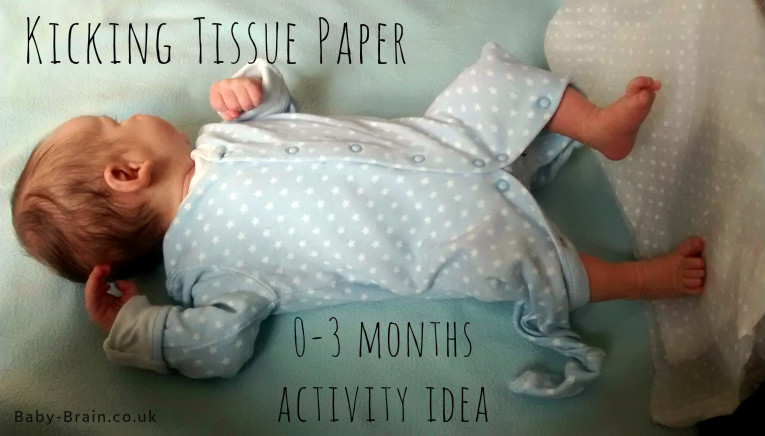
SIGHT
-
Mirroring, including mirroring noises and chatting, having a conversation
-
Face time
-
Tongue talk
-
Copy Cats
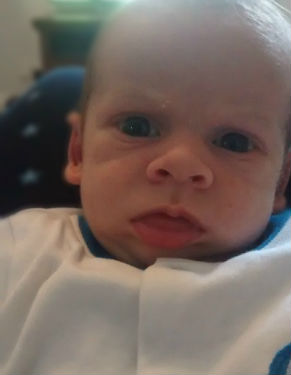
Nurrr
We spent a lot of time sticking our tongues out at each other! Given baby’s limited communication channels, this was something he was able to do and I sat there and “Mirrored” him, i.e. copying what he was doing and sticking my tongue out in response to him. This then turned into a kind of “conversation” where we would take it it turns. I then threw a few more facial expressions in and tongue clicks which seemed to interest him. This early study (6) writes that babies between 12-21 days old are able to imitate facial gestures, so you can try it from the first few weeks! Also loving the pictures in that article of the baby imitating “mouth opening” and especially the “lip protrusion”.
High contrast:

In terms of visual aspects and development, the visual system is not yet fully developed at birth (a). Baby has difficulty distinguishing between similar colours such as orange and red and so prefer high contrast colours such as black against white. We used several “high contrast” images and resources such as a black and white book and flash cards.
Let’s Face It
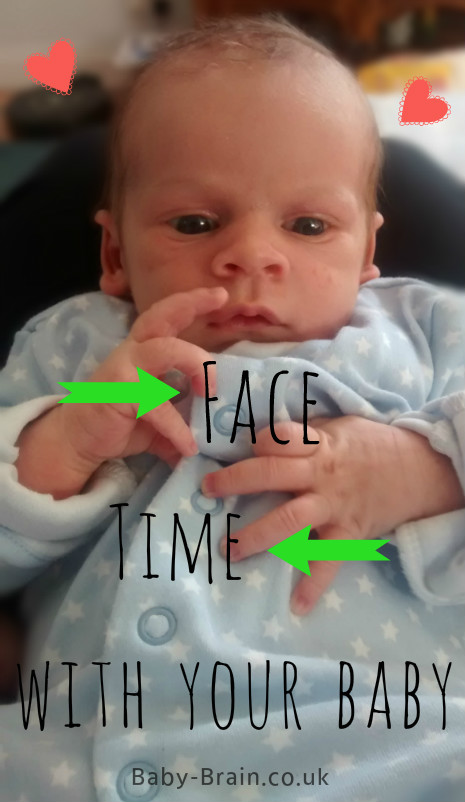
Who’s there?
Babies love looking at faces; even in the days after birth a baby will prefer to look at images of a face compared to other images. YOU are their favourite play thing and baby will be very interested in staring at you whilst you sing/talk/coocheecoo at them.
YOU are your baby’s favourite play thing!
Mirroring and attachment:
Here’s a good video about “marked mirroring” with your baby. The page has described it nicely so I’ll just quote here:
Facial expressions that help a baby to know his feelings are understood are known as ‘mirroring’. Mirroring is said to be ‘marked’ when the parent mirrors the emotion then quickly ‘marks’ the interaction with a reassuring expression. Mirroring shows the baby that he is understood and reflects the feeling he is experiencing.
The’marking’ helps the baby know the feeling belongs to him and that the parent understands but is not overwhelmed and is therefore able to help him or her to manage such feelings.
(Warwick Medical School, 2014, http://www.your-baby.org.uk/early-interactions/marked-mirroring-showing-they-understand-their-babys-emotions).
Home activities: Tummy Time, Mirror Play, Play Gym
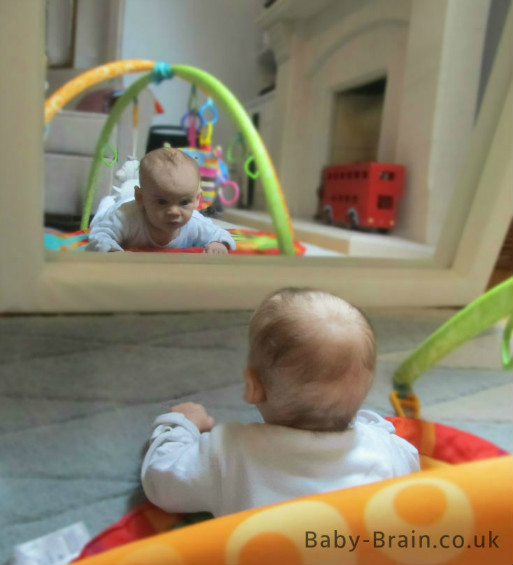
Who’s looking at you, kid?
Tummy Time, play in the mirror and play gym were some fun and easy activities we tried at home. See links for more information on these activities. Play gyms for example have some great cognitive, visual perception, grasping and reaching skills, gross motor skills, self-awareness and sensory stimulation benefits as summarized in this nice article here by Mama OT. Personally, I could really see the baby developing in terms of gross motor skills, coordination and crossing his midline to reach out and grasp at toys.
Getting out and about
At first I remember it seeming very daunting and difficult on a practical level to get out of the house. Add two kids to the mix and there seemed like even more obstacles and things “to do” before we could get out the front door. However, there are many benefits and aspects for parent and child including social and mental health elements. Here’s a page about choosing activities and benefits of them for maternal mental health.
Lastly: Enjoy this time with baby!
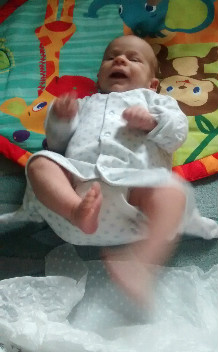
Wheee!
References:
- Decasper AJ, Fifer WP. Of human bonding: newborns prefer their mothers’ voice. Science. 1980;208:1174 –1176.
- Lariviere & Rennick (2011). Parent picture-book reading to infants in the neonatal intensive care unit as an intervention supporting parent-infant interaction and later book reading. Journal of Developmental & Behavioral Pediatrics, 32 (2), pp 146-152.
- Karras, J. & Braungart-Rieker, J. (2005). Effects of shared parent-infant book reading on early language acquisition. Applied Developmental Psychology, 26, 133-148.
- Julie Gros-Louis, Meredith J. West, Andrew P. King. The Influence of Interactive Context on Prelinguistic Vocalizations and Maternal Responses. Language Learning and Development, 2016; DOI:10.1080/15475441.2015.1053563
- Ardiel, E. L., & Rankin, C. H. (2010). The importance of touch in development. Paediatr Child Health. 2010 Mar; 15(3): 153–156.
- Ramírez-Esparza, N., García-Sierra, A., & Kuhl, P. K. (2014). Look who’s talking: speech style and social context in language input to infants are linked to concurrent and future speech development. Developmental Science, 17 (6): 880–891
a) Brémond-Gignac D., Copin H., Lapillonne A., Milazzo S. (2011). Visual development in infants: physiological and pathological mechanisms. Curr. Opin. Ophthalmol. 22, S1–S8.
I’m a Tourist Baby – Baby Friendly London & Kensington Palace
Baby Friendly London, and tourist adventures! This is also relevant to the wellbeing and mental health page where I discuss various activity ideas for fun times but also to reduce cabin fever and increase mood. Be a tourist in your own town, or actually go somewhere and be a tourist, with or without baby.
Anyway – here’s some things the Little Lovely got up as a Tourist, Baby.
Kensington Palace, London, England, UK – Website here
Age when visited: 7 months, 1 week
-
Nearest stations: How to find Kensington Palace information here. It’s a bit of a walk from the tube stations but those around the palace are: High Street Kensington, Queensway or Notting Hill Gate. These stations are NOT step free, so might be difficult with a buggy. Nearest National Rail station: London Paddington (further away than the tubes, though).
-
Nearby attractions: Hyde park and The Serpentine Gallery are “behind” Kensington Palace Gardens. You’re also not that far from the museums (15-20 minute walk): The Science Museum, Natural History Museum, Victoria and Albert Museum (art & design) and The Royal Albert Hall (not a museum; concerts). Really, in tourist town, and beware these venues get crowded especially at peak times.
What is there to do?
Well, in honour of Price George of Cambridge’s first birthday (2014) we went to the Palace (Kate and Wills have an apartment here)! Well actually, it wasn’t in honour of his birthday, we were just going anyway but when we got there we saw some birthday banners and balloons up for him, as you can see in the pictures above of the Little Lovely outside the Palace gates.
-
Princess Diana’s Dresses: Look back at fashion as worn by HM The Queen, Princess Margaret and Diana, Princess of Wales.
-
Queen Victoria: Learn about her life and see what kind of toys they had in the nursery! We played with some of them (not the originals, I assume – see picture). I got told off for sitting on the carpet with no shoes on, though. So keep your shoes on. I’ll assume the baby was fine to go shoeless.
-
Other: Explore the gardens and Orangery – Works of art – the Queen’s State Apartments and King’s State Apartments. There is also a shop.
The pictures below are of the main entrance room, with LL posing under a picture of Princess Diana, then in the royal nursery playing with some toys, in another room in the palace, and then spark out and tired at the end of a busy day as a tourist, baby.
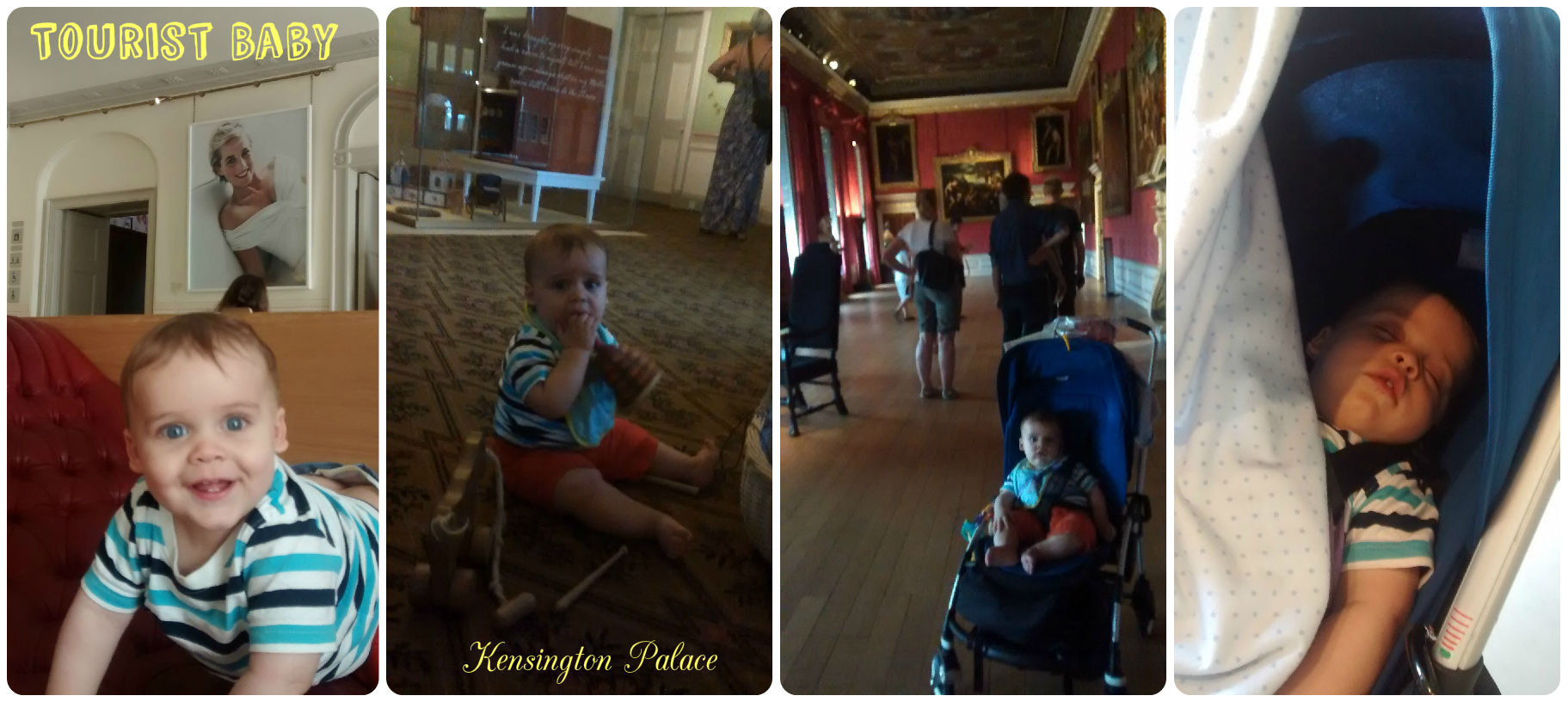 Eating:
Eating:
There is a cafe in the Orangery and Palace. I went to the Palace cafe and there are highchairs and kid’s meals available, such as children’s sandwich bags. If you want to bring your own food or do a picnic in the park the nearest shops are a bit of a walk away, and the cafe has tourist cafe prices, so stop off at the shops on the way if you prefer this cheaper option!
Baby and Toddler facilities:
There are changing facilities available. I don’t think there were any specific feeding or breastfeeding areas but a friend and I fed in the entrance area on some comfy seats and no one cared.
Accessibility for prams and those less able to use stairs:
There are lifts to most areas. Staff were very helpful and led me through a step-free route to view the fashion and Princess Diana’s dresses with my pram. I don’t know if this was a temporary arrangement or if this route is usually accessible without staff assistance. But either way, the staff were helpful and you could always ask if unsure. The website also writes that:
There is level access from Kensington Gardens to the palace, a lift to all floors and wheelchairs and portable seating to borrow during your visit. We also offer Describer Tours for blind and partially sighted visitors as well as facilitating British Sign Language tours.
In all, a reasonably baby friendly day out, and there’s the gardens/park to explore as well!
Psychological Research: Does having children make you any happier?
[spider_facebook id=”1″]
Research on: does having children make us any happier?
See the full article from the London School of Economics, here
In summary:
The birth of a first and a second child briefly increases the level of their parents’ happiness, but a third does not, according to new research from LSE and Western University, Canada
“According to the research, published in the journal Demography, parents’ happiness increases in the year before and after the birth of a first child, it then quickly decreases and returns to their ‘pre-child’ level of happiness”
“Those who become parents between the ages of 23 -34 have increasing happiness before a first birth, however one to two years after the birth, happiness decreases to baseline or below.”
“The arrival of a third child is not associated with an increase in the parents’ happiness, but this is not to suggest they are any less loved than their older siblings. Instead, this may reflect that the experience of parenthood is less novel and exciting by the time the third child is born or that a larger family puts extra pressure on the parents’ resources. Also, the likelihood of a pregnancy being unplanned may increase with the number of children a woman already has – and this brings its own stresses.”
-
So – they’re not saying there’s any link between no increase in happiness and not loving or looking after the child! (phew). I like the idea of it being less novel though, kind of makes sense, or other social/economic factors that could affect the “third child” (or later children in general) such as pressure on resources.
-
Baby-Brain thinks: Of course, “happiness”, will depend on what you want it to mean and there are going to be many other “changes” that come with children – positive, not so positive (?!) or just differences to one’s life that come with such a significant thing as having a child!


